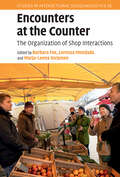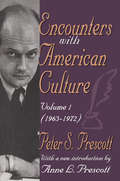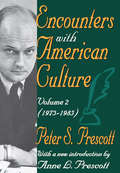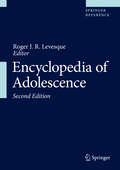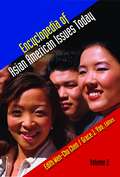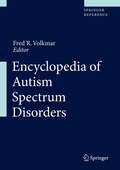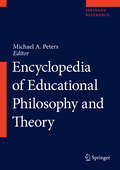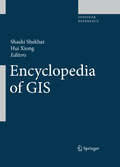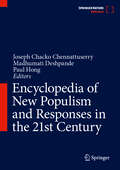- Table View
- List View
Encounters at the Counter: The Organization of Shop Interactions (Studies in Interactional Sociolinguistics)
by Lorenza Mondada Barbara Fox Marja-Leena SorjonenBringing together a diverse collection of studies from a team of international scholars, this pioneering volume focuses on interactions in shops, exploring the dynamics of conversation between sellers and customers. Beginning with the emergence of a 'need' for a product before the request to a seller is actually made, all the way through to the payment phase, it explores the rich and deeply methodical practices employed by customers and sellers as they go about the apparently mundane work of buying and selling small items. It looks at how seller and customer interact both verbally, and by means of manipulating the material objects involved, across a range of different kinds of purchase. Providing new insights into multimodal human interaction and the organisation of the commercial activity, it aims to bring about a new understanding of the fundamental ways in which economic value, possession and ownership is achieved.
Encounters with American Culture: Volume 1, 1963-1972
by Peter S. PrescottThis collection of essays discusses some of the important books, authors, and literary trends of a volatile era in American and world literature whose cultural repercussions are still being felt. Peter S. Prescott was one of the most penetrating, knowledgeable, and sensitive critics to write for a general audience in the tradition of Edmund Wilson. Readers will discover not only Prescott's acute and subtle comments on the enduring and/or representative books of the time, but also his humor and style, his way with an anecdote or aphorism, his talent for parody, and his ability to laugh at himself, as well as at the authors he sometimes skewers.Prescott's writing has an immediacy and vivacity that suggests what it was like to read new books during his time. Here is one critic's view--ironic and complex--of good books by famous writers like Norman Mailer, Jorge Luis Borges, Joyce Carol Oates, Aleksandr Solzhenitsyn, and Vladimir Nabokov, as well as of good books by little-known writers and others who would later achieve reknown. Here, too, is some astringent criticism of distinguished and popular authors who have fallen into self-indulgence. Prescott writes about the New Journalism in its early days and about fragmentary autobiography as a literary form--genres whose importance he was among the first to recognize. His essays also touch on theater, film, food, and politics.The criticism in this volume are examples of the literary essay in its truest sense--an attempt to explore, in however brief space allowed, what the author sees around him, and connections between books and other aspects of the way people live. Always personal and urbane, these essays are often hilarious, generally moving, and exemplify the essay as an art form.
Encounters with American Culture: Volume 2, 1973-1985
by Peter PrescottPeter S. Prescott was one of the most informed and incisive American literary critics to write for the general public. Never content merely to summarize or to pronounce quick judgments, Prescott's reviews are witty and delightful essays to be enjoyed for their own sake as examples of civilized discourse. Whether he is exploring a well-known novelist's outlook and methods, or the peculiar deficiencies of a work of nonfiction, Prescott's grace, elegance, and insights make each piece proof that real criticism need not be pedantic, obscure, or interminably long.The focus in this second volume of Prescott's writings published by Transaction is on both fiction by American authors and on nonfiction reflecting our American unease. He casts an ironic eye on how we in this country think we live now; on what we are saying about ourselves in our fiction, our history, and our biography. Prescott considers some of our century's classic writers: Hemingway and Henry Miller; John Cheever and Thornton Wilder. He offers new insights regarding those who are still at work: Mailer, John Irving, Oates, Updike, Ozick, and Alice Walker. Some authors do not fare well. With his customary flair; Prescott explains why the reputations of Kurt Vonnegut and Barbara Tuchman, the Encyclopedia Britannica, and John Gardner, urgently need deflation. He includes essays on writers and books not generally noticed in collections of criticism: Stephen King, The Joy of Sex, fairy tales, science fiction, thrillers, books on survival and etiquette. Here is a critic with a personal voice and a sense of style. For essays published in this collection, Prescott received the most highly regarded prize in journalism: the rarely presented George Polk Award for Criticism.This is a chronicle of our contemporary American culture as revealed by its books, written with verve, intelligence, wisdom, and wit by a critic who's cruel only when appropriate. Encounters with American Culture is, quite simply, literary journalism at its urbane best.
Encounters with the Invisible: Revisiting Spirit Possession in the Himalayas
by Anne De Sales Marie Lecomte–TilouineThis volume considers spirit possession in the Himalayas and the various ways in which invisible powers are made present. It does so by examining material representations of these powers through artefacts, animals, plants and natural substances, while also focusing on narratives of people’s encounters with the invisible that may help them to reconfigure reality. Through these two approaches, the contributions examine new phenomena associated with the concepts of "possession" and "shamanism", which otherwise tend to lead research into well-worn furrows. The book addresses a range of themes, including the gods of the Western Himalayas, death and ritual dissolution among Hyolmo Buddhists in Nepal, gods and rivers as legal persons in India, and the problem of conversion disorder in Nepal.Rich in ethnography, this book will be indispensable for scholars and researchers of anthropology, religion, spiritualism, sociology of religion, Himalayan studies, sociology and South Asia.
Encouraging Sustainable Behavior: Psychology and the Environment
by Hans C. M. van TrijpIncreasingly it is being recognized that consumer behavior may be a key trigger in the march toward sustainable development. Several lines of psychological theory and approaches have been developed relatively independently, each of which may provide major implications and action points on how consumers might be moved toward more sustainable behavior. This book is the first that brings together this variety of perspectives and theoretical angles around the common ambition of sustainable development. The contributors are all leading social scientists in the field of consumer behavior who met the challenge to sketch out their theoretical perspectives, but also to go beyond their normal theorizing and think out of the box in order to show how these theoretical perspectives might be made actionable in terms of key managerial and policy perspectives toward sustainable development. The result is a book that shows a wealth of information and approaches the question of how to encourage sustainable behavior from a myriad of divergent perspectives. This should stimulate scientists and policy-makers alike to find similarities, differences, and synergies between state-of-the-art psychological thinking about how to most effectively stimulate sustainable consumer behavior.
Encyclopedia of Adolescence
by Roger J.R. LevesqueThe Encyclopedia of Adolescence breaks new ground as an important central resource for the study of adolescence. Comprehensive in breath and textbook in depth, the Encyclopedia of Adolescence - with entries presented in easy-to-access A to Z format - serves as a reference repository of knowledge in the field as well as a frequently updated conduit of new knowledge long before such information trickles down from research to standard textbooks. By making full use of Springer's print and online flexibility, the Encyclopedia is at the forefront of efforts to advance the field by pushing and creating new boundaries and areas of study that further our understanding of adolescents and their place in society. Substantively, the Encyclopedia draws from four major areas of research relating to adolescence. The first broad area includes research relating to "Self, Identity and Development in Adolescence". This area covers research relating to identity, from early adolescence through emerging adulthood; basic aspects of development (e.g., biological, cognitive, social); and foundational developmental theories. In addition, this area focuses on various types of identity: gender, sexual, civic, moral, political, racial, spiritual, religious, and so forth. The second broad area centers on "Adolescents' Social and Personal Relationships". This area of research examines the nature and influence of a variety of important relationships, including family, peer, friends, sexual and romantic as well as significant nonparental adults. The third area examines "Adolescents in Social Institutions". This area of research centers on the influence and nature of important institutions that serve as the socializing contexts for adolescents. These major institutions include schools, religious groups, justice systems, medical fields, cultural contexts, media, legal systems, economic structures, and youth organizations. "Adolescent Mental Health" constitutes the last major area of research. This broad area of research focuses on the wide variety of human thoughts, actions, and behaviors relating to mental health, from psychopathology to thriving. Major topic examples include deviance, violence, crime, pathology (DSM), normalcy, risk, victimization, disabilities, flow, and positive youth development.
Encyclopedia of Adolescence
by Roger J.R. LevesqueThe second edition of this encyclopedia continues to break new ground as an important resource for the study of adolescence. Comprehensive in breath and textbook in depth, the second edition – with entries presented in easy-to-access A to Z format – serves as a reference repository of knowledge in the field as well as a frequently updated conduit of new research and knowledge long before such information trickles down to standard textbooks. This updated and expanded major reference work advances the field by pushing and creating new boundaries and areas of study that further our understanding of adolescents and their place in society. In addition to the original 730 entries, the new edition adds more than 200 new essays as well as updates to many other entries. Substantively, the second edition continues to draw from four major areas of research relating to adolescence:The first broad area includes research relating to "Self, Identity and Development in Adolescence"The second broad area centers on "Adolescents’ Social and Personal Relationships".The third area examines "Adolescents in Social Institutions"."Adolescent Mental Health" constitutes the last major area of research.This unique, comprehensive second edition of the Encyclopedia of Adolescence is an essential reference for advanced undergraduate and graduate students as well as researchers, professors, clinicians, and other practitioners across such related disciplines as developmental psychology, criminology and criminal Justice, adolescent psychiatry, child and school psychology, family, and public health.
Encyclopedia of African American Religions (Religious Information Systems)
by J. Gordon Melton Larry G. Murphy Gary L. WardPreceded by three introductory essays and a chronology of major events in black religious history from 1618 to 1991, this A-Z encyclopedia includes three types of entries: * Biographical sketches of 773 African American religious leaders* 341 entries on African American denominations and religious organizations (including white churches with significant black memberships and educational institutions)* Topical articles on important aspects of African American religious life (e.g., African American Christians during the Colonial Era, Music in the African American Church)
Encyclopedia of American Prisons (Garland Studies in the History of American Labor)
by Marilyn D. McShane Frank P. WilliamsFirst Published in 1996. Routledge is an imprint of Taylor & Francis, an informa company.
Encyclopedia of Animal Rights and Animal Welfare: [2 Volumes] (Non-ser.)
by Marc Bekoff Carron A. MeaneyHuman beings' responsibility to and for their fellow animals has become an increasingly controversial subject. This book provides a provocative overview of the many different perspectives on the issues of animal rights and animal welfare in an easy-to-use encyclopedic format. Original contributions, from over 125 well-known philosophers, biologists, and psychologists in this field, create a well-balanced and multi-disciplinary work. Users will be able to examine critically the varied angles and arguments and gain a better understanding of the history and development of animal rights and animal protectionist movements around the world. Outstanding Reference Source Best Reference Source
Encyclopedia of Asian American Issues Today, Volume 1
by Edith W. Chen Grace J. YooEncyclopedia of Asian American Issues Today is the first major reference work focused on the full expanse of contemporary Asian American experiences in the United States. Drawing on over two decades of research, it takes an unprecedented look at the major issues confronting the Asian American community as a whole, and the specific ethnic identities within that community--from established groups such as Chinese, Japanese, and Korean Americans to newer groups such as Cambodian and Hmong Americans.Across two volumes, Encyclopedia of Asian American Issues Today offers 110 entries on the current state of affairs, controversies, successes, and outlooks for future for Asian Americans. The set is divided into 11 thematic sections including diversity and demographics; education; health; identity; immigrants, refugees, and citizenship; law; media; politics; war; work and economy; youth, family, and the aged. Contributors include leading experts in the fields of Asian American studies, education, public health, political science, law, economics, and psychology.
Encyclopedia of Asian American Issues Today, Volume 2
by Edith W. Chen Grace J. YooEncyclopedia of Asian American Issues Today is the first major reference work focused on the full expanse of contemporary Asian American experiences in the United States. Drawing on over two decades of research, it takes an unprecedented look at the major issues confronting the Asian American community as a whole, and the specific ethnic identities within that community--from established groups such as Chinese, Japanese, and Korean Americans to newer groups such as Cambodian and Hmong Americans.Across two volumes, Encyclopedia of Asian American Issues Today offers 110 entries on the current state of affairs, controversies, successes, and outlooks for future for Asian Americans. The set is divided into 11 thematic sections including diversity and demographics; education; health; identity; immigrants, refugees, and citizenship; law; media; politics; war; work and economy; youth, family, and the aged. Contributors include leading experts in the fields of Asian American studies, education, public health, political science, law, economics, and psychology.
Encyclopedia of Autism Spectrum Disorders
by Fred R. VolkmarThis major reference work breaks new ground as an electronic resource for students, educators, researchers, and professionals. Comprehensive in breath and textbook in depth, the Encyclopedia of Autism Spectrum Disorders serves as a reference repository of knowledge in the field as well as a regularly updated conduit of new knowledge long before such information trickles down from research to standard textbooks. The Encyclopedia consists of 5 volumes and approximately 1,500 entries divided by the major conceptual areas of ASD and PDDs, including: - Research trends and findings - Behavior/speech - Communication - Treatments - Education Taking advantage of the techniques offered by the electronic medium, the Encyclopedia of Autism Spectrum Disorders offers an extensive cross-referencing system facilitating search and retrieval of information.
Encyclopedia of Behavioral Medicine
by Marc Gellman J. Rick TurnerFrom Neil Schneiderman's Foreword: Because behavioral medicine has been constructed based on the understanding of relationships among behavior, psychosocial processes, and sociocultural contexts, the field is well positioned to take a leadership role in informing future health care policies. The field of behavioral medicine appears to have a bright, important future.... A small sampling of entries from Encyclopedia of Behavioral Medicine: Abuse, child; Active coping; Adherence; Adrenaline; AIDS; Back pain; Behavioral medicine; Benefit-risk estimation; Binge eating; Bogalusa Heart Study; Cachexia; Cancer prevention; Cancer, testicular; Children's Health Study; Chronobiology; Coping strategies; Database development and management; Death, assisted; Developmental disabilities; Diabetes; Disparities; Eating disorders; Ecosocial theory; Effect modification; End-of-life care; Epigenetics; Expressive writing and health; Fall risk behavior; Family practice/medicine; Family, relationships; Fatigue; Foot care; Functional somatic syndromes; Galvanic skin response ; Gender differences ; Gene-environment interaction; Genetic polymorphisms ; Genital herpes ; Hamilton Anxiety Scale; Headaches, types of; Health systems; Hearing loss; Heart failure; Heart rate; Illness behavior; Immune function; Insomnia; Integrative medicine; Ischemic heart disease; Kaposi sarcoma; Kuopio Ischemic Heart Disease Study; Learned helplessness; Lifespan; Lifestyle, sedentary; Lipid abnormalities; Loneliness; Lung function; Magnetic resonance imaging; Maternal stress; Mean (average); Medication compliance; Methodology; Mini Mental State Examination; National Cancer Institute; National Children's Study; Negative affect; Neuroendocrine activation; Nigh shift workers and health; Obesity; Occupational therapy; Organ transplantation; Osteopenia/osteoporosis; Oxytocin; Pain; Pain anxiety; Palliative care; Panic attack; Physical activity interventions; Placebo effect; Post-traumatic stress disorder; Racism; Randomized clinical trial; Regression analysis; Resilience; Risk perception; Risky behavior; Secondary prevention; Selye, Hans; Self-medication; Self-monitoring; Stress test; Successful aging; Tachycardia; Theory of planned behavior; Therapy, physical; Tinnitus; Twin studies; Unipolar depression; Usual care; Validity; Vasoconstriction; Vassopressin; Verbal Rating Scale; Weiss, Stephen M.; Women's health; Women's Health Initiative; Worry; Wound healing; Yoga; Zung Depression Inventory
Encyclopedia of Early Childhood Education (Routledge Library Editions: Education)
by Doris Pronin Fromberg Leslie R. WilliamsThis Encyclopedia is a reference work about young children in the USA, designed for use by policy makers, community planners, parents of young children, teacher and early childhood educators, programme and school administrators, among others. The field of early childhood education has been affected by changes taking place in the nation’s economy, demographics, schools, communities and families that influence political and professional decisions. These diverse historical, political economic, socio-cultural, intellectual and educational influences on early childhood education have hindered the development of a clear definition of the field. The Encyclopedia provides an opportunity to define the field against the background of these influences and relates the field of early childhood education to its diverse contexts and to the cultural and technological resources currently affecting it.
Encyclopedia of Educational Philosophy and Theory
by Michael A. PetersThis encyclopaedia is a dynamic reference and study place for students, teachers, researchers and professionals in the field of education, philosophy and social sciences, offering both short and long entries on topics of theoretical and practical interest in educational theory and philosophy by authoritative world scholars representing the full ambit of education as a rapidly expanding global field of knowledge and expertise. This is an encyclopaedia that is truly global and while focused mainly on the Western tradition is also respectful and representative of other knowledge traditions. It professes to understand the globalization of knowledge. It is unique in the sense that it is based on theoretical orientations and approaches to the main concepts and theories in education, drawing on the range of disciplines in the social sciences. The encyclopaedia privileges the "theory of practice", recognizing that education as a discipline and activity is mainly a set of professional practices that inherently involves questions of power and expertise for the transmission, socialization and critical debate of competing norms and values.
Encyclopedia of GIS
by Shashi Shekhar Hui XiongThe Encyclopedia of GIS provides a comprehensive and authoritative guide, contributed by experts and peer-reviewed for accuracy, and alphabetically arranged for convenient access. The entries explain key software and processes used by geographers and computational scientists. Major overviews are provided for nearly 200 topics: Geoinformatics, Spatial Cognition, and Location-Based Services and more. Shorter entries define specific terms and concepts. The reference will be published as a print volume with abundant black and white art, and simultaneously as an XML online reference with hyperlinked citations, cross-references, four-color art, links to web-based maps, and other interactive features.
Encyclopedia of Gay Histories and Cultures (Encyclopedias of Contemporary Culture)
by George E. HaggertyFirst Published in 2000. Routledge is an imprint of Taylor & Francis, an informa company.
Encyclopedia of Heroism Studies
by George R. Goethals Scott T. Allison James K. BegganThis reference work is an important resource in the growing field of heroism studies. It presents concepts, research, and events key to understanding heroism, heroic leadership, heroism development, heroism science, and their relevant applications to businesses, organizations, clinical psychology, human wellness, human growth potential, public health, social justice, social activism, and the humanities. The encyclopedia emphasizes five key realms of theory and application: Business and organization, focusing on management effectiveness, emotional intelligence, empowerment, ethics, transformational leadership, product branding, motivation, employee wellness, entrepreneurship, and whistleblowers; clinical-health psychology and public health, focusing on stress and trauma, maltreatment, emotional distress, bullying, psychopathy, depression, anxiety, family disfunction, chronic illness, and healthcare workers’ wellbeing; human growth and positive psychology, discussing altruism, authenticity, character strengths, compassion, elevation, emotional agility, eudaimonia, morality, empathy, flourishing, flow, self-efficacy, joy, kindness, prospection, moral development, courage, and resilience; social justice and activism, highlighting anti-racism, anti-bullying, civil disobedience, civil rights heroes, climate change, environmental heroes, enslavement heroes, human rights heroism, humanitarian heroes, inclusivity, LGBTQ+ heroism, #metoo movement heroism, racism, sustainability, and women’s suffrage heroes; and humanities, relating to the mythic hero’s journey, bliss, boon, crossing the threshold, epic heroes, fairy tales, fiction, language and rhetoric, narratives, mythology, hero monomyth, humanities and heroism, religious heroes, and tragic heroes.
Encyclopedia of Homosexuality: Volume I (Routledge Revivals: Encyclopedia of Homosexuality)
by Stephen Donaldson Wayne R. Dynes Warren Johansson William A. PercyFirst published in 1990, The Encyclopedia of Homosexuality brings together a collection of outstanding articles that were, at the time of this book’s original publication, classic, pioneering, and recent. Together, the two volumes provide scholarship on male and female homosexuality and bisexuality, and, reaching beyond questions of physical sexuality, they examine the effects of homophilia and homophobia on literature, art, religion, science, law, philosophy, society, and history. Many of the writings were considered to be controversial, and often contradictory, at that time, and refer to issues and difficulties that still exist today. This volume contains entries from A-L.
Encyclopedia of Homosexuality: Volume II (Routledge Revivals: Encyclopedia of Homosexuality)
by Stephen DonaldsonFirst published in 1990, The Encyclopedia of Homosexuality brings together a collection of outstanding articles that were, at the time of this book’s original publication, classic, pioneering, and recent. Together, the two volumes provide scholarship on male and female homosexuality and bisexuality, and, reaching beyond questions of physical sexuality, they examine the effects of homophilia and homophobia on literature, art, religion, science, law, philosophy, society, and history. Many of the writings were considered to be controversial, and often contradictory, at that time, and refer to issues and difficulties that still exist today. This volume contains entries from M-Z.
Encyclopedia of Immigrant Health
by Martha Sajatovic Sana LoueThere is increasing interest in the scientific literature on immigrant health and its impact on disease transmission, disease prevention, health promotion, well-being on an individual and population level, health policy, and the cost of managing all these issues on an individual, institutional, national, and global level. The need for accurate and up-to-date information is particularly acute due to the increasing numbers of immigrants and refugees worldwide as the result of natural disasters, political turmoil, the growing numbers of immigrants to magnet countries, and the increasing costs of associated health care that are being felt by governments around the world. Format and Scope: The first portion of the encyclopedia contains chapters that are approximately 25 to 40 manuscript pages in length. Each overview chapter includes a list of references and suggested readings for cross referencing within the encyclopedia. The opening chapters are: Immigration in the Global Context, Immigration Processes and Health in the U.S.: A Brief History, Alternative and Complementary Medicine, Culture-Specific Diagnoses, Health Determinants, Occupational and Environmental Health, Methodological Issues in Immigrant Health Research, Ethical Issues in Research with Immigrants and Refugees, Ethical Issues in the Clinical Context. The second portion of the book consists of alphabetical entries that relate to the health of immigrants. Entries are interdisciplinary and are drawn from the following fields of study: anthropology, demographics, history, law, linguistics, medicine, population studies, psychology, religion, and sociology. Each entry is followed by a listing of suggested readings and suggested resources, and also links to related terms within the whole book. Outstanding Features The book adopts a biopsychosocial-historical approach to the topics covered in the chapters and the entries. Each entry includes suggested readings and suggested resources. The chapters and entries are written graduate level that is accessible to all academics, researchers, and professionals from diverse backgrounds. We consider the audience for the entries to be well educated, but a non expert in this area. The primary focus of the book is on the immigrant populations in and immigration to magnet countries. References are made to worldwide trends and issues arising globally. In addition to the comprehensive subject coverage the text also offers diverse perspectives. The editors themselves reflect the multidisciplinary nature of the topics, with expertise in psychiatry, law, epidemiology, anthropology, and social work. Authors similarly reflect diverse disciplines.
Encyclopedia of Lesbian Histories and Cultures: An Encyclopedia (Encyclopedias of Contemporary Culture)
by Bonnie ZimmermanA rich heritage that needs to be documented Beginning in 1869, when the study of homosexuality can be said to have begun with the establishment of sexology, this encyclopedia offers accounts of the most important international developments in an area that now occupies a critical place in many fields of academic endeavours. It covers a long history and a dynamic and ever changing present, while opening up the academic profession to new scholarship and new ways of thinking. A groundbreaking new approach While gays and lesbians have shared many aspects of life, their histories and cultures developed in profoundly different ways. To reflect this crucial fact, the encyclopedia has been prepared in two separate volumes assuring that both histories receive full, unbiased attention and that a broad range of human experience is covered. Written for and by a wide range of people Intended as a reference for students and scholars in all fields, as well as for the general public, the encyclopedia is written in user-friendly language. At the same time it maintains a high level of scholarship that incorporates both passion and objectivity. It is written by some of the most famous names in the field, as well as new scholars, whose research continues to advance gender studies into the future.
Encyclopedia of Lesbian and Gay Histories and Cultures
by George E. HaggertyBeginning in 1869, when the study of homosexuality can be said to have begun with the establishment of sexology, this Encyclopedia offers accounts of the most important international developments in an area that now occupies a critical place in many fields of academic endeavours. While gays and lesbians have shared many aspects of life, their histories and cultures developed in profoundly different ways. To reflect this crucial fact, the Encyclopedia has been prepared in two separate volumes assuring that both histories receive full, unbiased attention and that a broad range of human experience is covered.Written by some of the most famous names in the field, as well as new researchers this is intended as a reference for students and scholars in all areas of study, as well as the general public.
Encyclopedia of New Populism and Responses in the 21st Century
by Paul Hong Joseph Chacko Chennattuserry Madhumati DeshpandeThis book mainly seeks to explain, define and update the recurring forms of populism in the 21st century. Examples used in this Introduction are limited to English speaking countries. But populism's existent expressions are ecumenically global. Like any long-lasting perennial organism it is sturdy and comes in a variety of forms adaptable to environmental changes. In political or cultural terms its expression has been neither exclusively left, center, nor right. Populism contains multitudes, dates back centuries before it was identified with its modern name. Populism has become a hot button issue in the recent times. The UK's Sunday heavy The Guardian published about 300 articles in 1998 that used the term "populism" or "populist" and by 2016 its use had skyrocketed to over 2,000. And growing. Probably the single greatest catalyst to date that injected populism into the world's Internet common discourse, that infused it into journalism right, left and centerand awakened populist political activism was the Great Recession of 2007-08 and the subsequent global deprivations it engendered. In today's world populism promises to remain and renew its intensity due to the covid-19 pandemic's deleterious effects on most nations middle and low-income groups, specially minorities. These are some reasons among many why it is time for populism to be relocated, identified and given refreshed 21st understandings. It has a shifting nature among people, events, causes that constantly demands fresh studies. It is a social and cultural phenomenon both universal and particular. In our 21st century world it is a product of our shared cultures and each our own exceptional deep culture. This Encyclopedia is unique in its composition as it includes all the major disciplines of Social Sciences and thus will be a one stop source of nine different disciplines looking at new populism.
